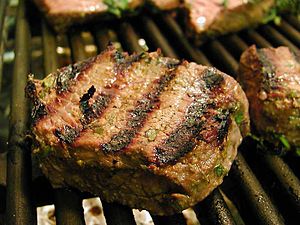When it comes to steak, we all have our own idea of what is perfect. Some of us like it red and rare while others don’t think it is done until the outside resembles charcoal. But no matter how we like it, we can all agree that there is nothing better than a farm fresh Arizona steak cooked just the way we like it.
Many of us, however, struggle to replicate that succulent steak we ate at the local steakhouse back home in our own kitchen. Eating out is great, but being able to make the perfect steak at home means you can have it whenever you want without having to break the bank.
Local rancher, Kacie Tomerlin from Arizona Legacy Beef offered her advice on how to grill the perfect steak during a featured spot on Sonoran Living. Here is Kacie’s advice on what goes into making the perfect steak.
First, the meat matters. Meat that is higher quality will produce better flavors. Kacie also noted that grass-fed beef and grain-fed beef can have a slightly different flavor and that cooking time may vary slightly between the two types of beef. No matter what kind of beef you pick make sure it has good marbling throughout. Kacie says that she likes her steak nice and thick and the steak she uses to demonstrate is about an inch and a half thick.
Once you have selected the perfect steak, you need to let it rest. Kacie indicates that this is one of the biggest mistakes many home cooks make when grilling or cooking steak. In order for the steak to be as good as it can be, you need to let it settle to room temperature before cooking. Most people take the steak right from the refrigerator to the grill, fearing foodborne illness but this keeps the muscle tissue in the meat tight which impacts how tender the steak will be after cooking. Kacie says when the steak feels room temperature to the touch, its grilling time.
The next step is seasoning, which is really up to you and your taste. In her demonstration, Kacie uses a little mineral salt but she says you can use whatever seasons suit your taste. After seasoning, the steak is ready to start grilling.
While some people like to get a nice sear on the exterior of their steak, Kacie prefers the low and slow approach. She gets the grill going to medium heat, about 350-400° and then sets the steak directly on the grill. Another mistake many of us make is to move the steak around too much while it is cooking which can affect how evenly the steak cooks and cause it to lose more of its natural juices. Kacie says the best way is to cook if for 3-5 minutes on each side, turning it only once. To determine if your steak is done, both Kacie and the American Beef Council state that the only way to know for sure is to use a meat thermometer. Kacie recommends inserting the thermometer after you turn the steak. For rare steak, you are looking for an internal temperature of around 140°, for medium rare you want the interior temp to be closer to 160°. Make sure the meat thermometer isn’t touching any cookware or bone to guarantee you get an accurate temperature. To see Kacie’s demonstration, watch the video available on the Fill Your Plate Blog. For information on safe grilling temperatures for steak and other meat, check the Beef Council’s Determining Doneness chart.
Related articles
- Tis The Season to Grill Safely (fillyourplate.org)
- The Recent Beef? We’re Eating More Ground Beef and Less Steak (fillyourplate.org)
- Fall in Love All Over Again this February… With Beef! (fillyourplate.org)


